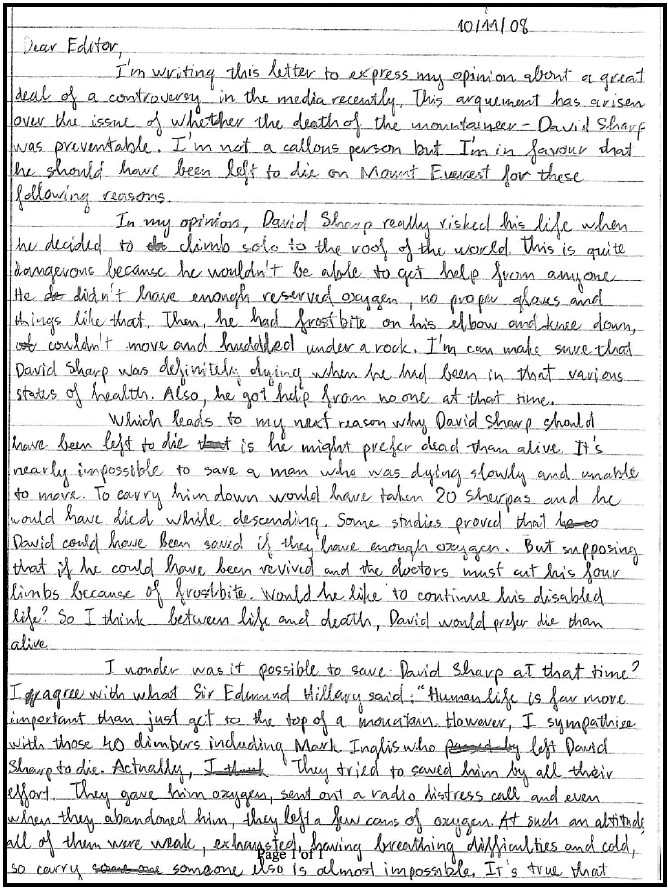Student information
The student is 16 years old and in Year 10. He came from Vietnam and speaks Vietnamese. He has had age equivalent schooling in Vietnam where he also took English classes. He spent two terms in an English language centre in Victoria.
Task
Students respond to an issue that was covered in class over a period of approximately four weeks. They gathered information, reviewed newspaper articles on the issues and engaged in oral discussion and debate. The students completed information and essay grids. No model was provided.


Text
Dear Editor,
I'm writing this letter to express my opinion about a great deal of controversy in the media recently. This argument has arisen over the issue of whether the death of the mountaineer – David Sharp was preventable. I'm not a callous person but I'm in favour that he should have been left to die on Mount Everest for the following reasons.
In my opinion, David Sharp really risked his life when he decided to climb solo to the roof of the world. This is quite dangerous because he wouldn’t be able to get help from anyone. He didn’t have enough reserved oxygen, no proper gloves and things like that. Then, he had frostbite on his elbow and knee down, couldn’t move and huddled under a rock. I’m can make sure that David Sharp was definitely dying when he had been in that various states of health. Also, he got help from no one at that time.
Which leads to my next reason why David Sharp should have been left to die is he might prefer dead than alive. It’s nearly impossible to save a man who was dying slowly and unable to move. To carry him down would have taken 20 Sherpas and he would have died while descending. Some studies proved that David could have been saved if they have enough oxygen. But supposing that if he could have been revived and the doctors must cut his four limbs because of frostbite, would he like to continue his disabled life? So I think between life and death, David would prefer die than alive.
I wonder was it possible to save David Sharp at that time? I agree with what Sir Edmund Hillary said: “Human life is far more important that just get to the top of a mountain. However I sympathise with those 40 climbers including Mark Inglis who left David Sharp to die. Actually, they tried to save him by all their effort. They gave him oxygen, sent out radio distress call and even when they abandoned him, they left him a few cans of oxygen. At such an altitude, all of them were weak, exhausted, having breathing difficulties and cold, so carry someone else is almost impossible. It’s true that human life is very important. If those 40 climbers saved David Sharp and some of them could died with him. Is that a bigger loss of human life? Therefore, I think their responsibility is save themselves, not anyone else.
The death of David Sharp is really a tragedy. However, I think death would be better for him and I believe those 40 climbers did nothing wrong. If you were there, you would do the same things as what they do. You love your life, don’t you?
This sample of student work demonstrates that the student can:
- Write a range of extended texts using the structures appropriate to the text types
(VCEALL785)
- Write a range of cohesive texts with accuracy
(VCEALL786)
- Use an extended range of cohesive devices to improve fluency
(VCEALL787)
- Demonstrate control of appropriate grammatical structures that develop the ways to analyse, argue, persuade, describe, classify or explain
(VCEALL788)
- Combine simple sentences into complex sentences using embedding structures
(VCEALL789)
- Demonstrate control of a wide range of verb forms
(VCEALL790)
- Use relative clauses and adjectival expressions for descriptive purposes
(VCEALL791)
- Use an expanded vocabulary appropriate for the curriculum area
(VCEALL793)
- Write an extended argument or discussion on a familiar issue
(VCEALC777)
- Understand how writing contexts, audience and purpose influence function and form
(VCEALA780)
- Plan and draft text independently and through group activities
(VCEALA781)
Possible next steps for this student's learning
- Using complex sentences that include embedded or relative clauses
(VCEALL789)
- Using a greater range of connectives, for example,
despite this…nevertheless
(VCEALL787)
Pathways and transitions considerations
A Year 10 student who is working within the range of C4 in any one language mode is not ready to transition to the English curriculum regardless of their proficiency in the other two language modes. This student will continue on Pathway C of the EAL curriculum in all language modes.
A Year 10 student should consistently demonstrate the final achievement standard in Pathway C (Level C4) in all three language modes before they transition to the English curriculum.
They will need to be equally capable across all three language modes to be able to meet the learning expectations in the English curriculum at the level taught to their mainstream peers, and without substantial language support.
They will need to be sufficiently proficient in understanding and using the academic language across the learning areas to participate in learning activities across the Victorian curriculum.
They will also need to be able to understand and use the academic English of the curriculum in subsequent years without substantial language support, when the cognitive and linguistic demands of the Victorian curriculum increase.
Depending on whether the student meets the eligibility criteria, they may be able to undertake VCE EAL in Year 12.